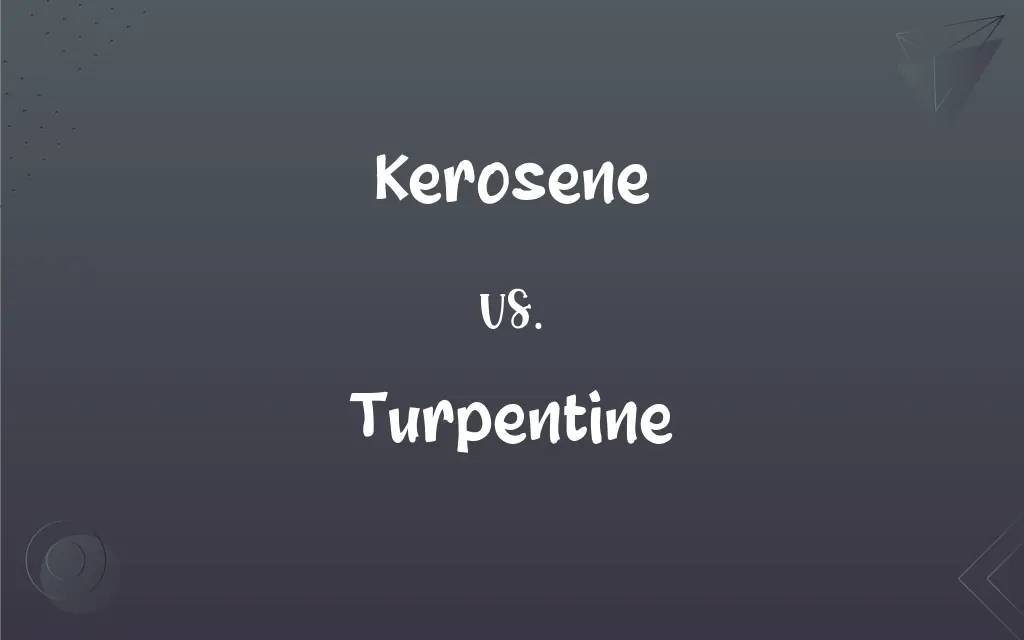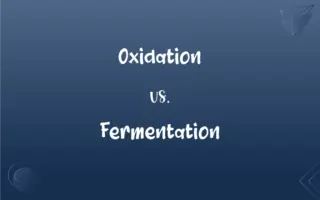Kerosene vs. Turpentine: What's the Difference?
Edited by Aimie Carlson || By Harlon Moss || Published on December 31, 2023
Kerosene is a petroleum-derived fuel used for heating and lighting; turpentine is a volatile oil used as a solvent and in making varnishes.

Key Differences
Kerosene is a light fuel oil obtained by distilling petroleum, primarily used for heating, lighting, and jet fuel. It is less volatile than gasoline and has a higher boiling point. Turpentine, conversely, is distilled from the resin of certain pine trees and is commonly used as a solvent in the paint industry. It is known for its strong odor and is also used in the production of varnishes and as a raw material in the chemical industry.
Kerosene was historically important for providing lighting before the widespread use of electricity. It burns with a clean flame, making it suitable for use in lanterns and heaters. Turpentine has been used for centuries as a thinner for oil-based paints and varnishes. Its strong solvent properties make it effective in dissolving oils, resins, and waxes.
Kerosene is less flammable than many other fuels, such as gasoline, due to its higher flash point. This property makes it relatively safer for storage and handling. Turpentine is more volatile and flammable compared to kerosene. Its strong fumes make it necessary to use in well-ventilated areas to avoid inhalation risks.
Kerosene is produced through the refining process of crude oil, where it is separated from other petroleum products at specific boiling points. Turpentine, on the other hand, is derived from a natural source - the resin of pine trees. Its extraction involves the distillation of the resin, separating the oil from the solid rosin.
Kerosene has limited use in industrial solvents due to its oily nature and relatively lower solvency for paints compared to turpentine. Turpentine is highly valued in the art world, especially for thinning oil paints and cleaning brushes, due to its effectiveness in dissolving oil-based substances.
ADVERTISEMENT
Comparison Chart
Source
Distilled from petroleum
Distilled from pine tree resin
Primary Use
Heating, lighting, jet fuel
Solvent, paint thinner, varnish component
Flammability
Less flammable, higher flash point
Highly flammable, volatile
Industrial Application
Limited solvent use, heating fuel
Widely used in paint and varnish industries
Properties
Oily, lower solvency for paints
Strong solvent, effective for oil-based paints
ADVERTISEMENT
Kerosene and Turpentine Definitions
Kerosene
Kerosene is a combustible hydrocarbon liquid used as fuel in heaters and lamps.
The old lantern in the cabin was fueled by kerosene.
Turpentine
Turpentine is used in the production of varnishes and resins.
To create the varnish, she mixed linseed oil with turpentine.
Kerosene
Kerosene is obtained from petroleum and used in jet engines.
The aircraft was powered by a type of jet fuel derived from kerosene.
Turpentine
Turpentine is distilled from the resin of pine trees.
The strong smell of turpentine filled the artist's studio, a scent reminiscent of pine forests.
Kerosene
Kerosene serves as a heating oil in residential and commercial buildings.
During the winter, they relied on kerosene to heat their home.
Turpentine
Turpentine serves as a raw material in the chemical industry.
The factory processed turpentine for various chemical products.
Kerosene
Kerosene is used in portable stoves and lanterns for camping.
They lit a kerosene stove to cook dinner at the campsite.
Turpentine
Turpentine is a volatile oil used as a paint thinner and solvent.
He used turpentine to thin the oil paint for his canvas.
Kerosene
Kerosene is a less volatile alternative to gasoline for fuel storage.
For emergency situations, they stored kerosene due to its safer handling properties.
Turpentine
Turpentine is known for its strong, pungent odor.
Opening the bottle of turpentine, the pungent aroma quickly spread through the room.
Kerosene
A thin oil distilled from petroleum or shale oil, used as a fuel for heating and cooking, in lamps, and as a denaturant for alcohol. Also called coal oil.
Turpentine
A thin volatile terpenoid essential oil, C10H16, obtained by steam distillation or other means from the wood or exudate of certain pine trees and used as a paint thinner, solvent, and medicinally as a liniment. Also called oil of turpentine, spirit of turpentine.
Kerosene
A thin colorless to straw-colored petroleum-based fuel heavier than gasoline/petrol or naptha but lighter than diesel, used primarily as jet fuel but also for heating and lighting in some remote or impoverished areas.
The kerosene lasted all winter, so the furnace kept us always warm.
Turpentine
The sticky mixture of resin and volatile oil from which turpentine is distilled.
Kerosene
An oil used for illuminating purposes, formerly obtained from the distillation of mineral wax, bituminous shale, etc., and hence called also coal oil. It is now produced in immense quantities, chiefly by the distillation and purification of petroleum. It consists chiefly of several hydrocarbons of the methane series, having from 10 to 16 carbon atoms in each molecule, and having a higher boiling point (175 - 325° C) than gasoline or the petroleum ethers, and a lower boling point than the oils.
Turpentine
A brownish-yellow resinous liquid obtained from the terebinth.
Kerosene
A flammable hydrocarbon oil used as fuel in lamps and heaters
Turpentine
To apply turpentine to or mix turpentine with.
Turpentine
To extract turpentine from (a tree).
Turpentine
Any oleoresin secreted by the wood or bark of certain trees.
Turpentine
A volatile essential oil now obtained from such oleoresin of from the wood of pine trees by steam distillation; a complex mixture of monoterpenes; now used as a solvent and paint thinner.
Turpentine
(transitive) To drain resin from (a tree) for use in making turpentine.
Turpentine
A semifluid or fluid oleoresin, primarily the exudation of the terebinth, or turpentine, tree (Pistacia Terebinthus), a native of the Mediterranean region. It is also obtained from many coniferous trees, especially species of pine, larch, and fir.
Turpentine
Obtained from conifers (especially pines)
Turpentine
Volatile liquid distilled from turpentine oleoresin; used as paint thinner and solvent and medicinally
FAQs
How is kerosene produced?
Kerosene is produced by refining crude oil, separating it based on boiling points.
Is kerosene flammable?
Kerosene is flammable but less volatile compared to fuels like gasoline.
What is the source of turpentine?
Turpentine is sourced from the distillation of pine tree resin.
What is kerosene primarily used for?
Kerosene is commonly used as fuel in heating, lighting, and jet engines.
How does turpentine benefit the art industry?
Turpentine is valuable in the art industry for thinning paints and cleaning brushes.
What is the environmental impact of kerosene?
Kerosene, like other fossil fuels, contributes to air pollution and greenhouse gas emissions.
How flammable is turpentine?
Turpentine is highly flammable and requires careful handling.
Can kerosene be used as a solvent?
Kerosene has limited use as a solvent due to its oily nature.
What precautions are needed when using kerosene?
When using kerosene, proper storage and handling are essential to prevent fires.
What are the main uses of turpentine?
Turpentine is mainly used as a solvent for paint and in producing varnishes.
Is turpentine still widely used today?
Turpentine continues to be used, especially in the paint and varnish industries.
Why is ventilation important when using turpentine?
Turpentine's strong fumes necessitate well-ventilated areas to avoid inhalation risks.
What safety measures should be taken with turpentine?
Turpentine requires careful handling, including avoiding skin contact and inhalation.
How does kerosene compare to gasoline?
Kerosene has a higher boiling point and is less volatile than gasoline.
What makes turpentine effective as a paint thinner?
Turpentine's strong solvent properties make it effective for thinning oil-based paints.
How should kerosene be stored?
Kerosene should be stored in a well-ventilated area in a container designed for flammable liquids.
Is kerosene used in aviation?
Yes, kerosene is used as jet fuel in aviation due to its high energy content.
Can turpentine be made synthetically?
Yes, there are synthetic versions of turpentine available.
What industries rely on kerosene?
The aviation, heating, and lighting industries commonly use kerosene.
What other applications does turpentine have?
Besides being a solvent, turpentine is used in making resins and chemicals.
About Author
Written by
Harlon MossHarlon is a seasoned quality moderator and accomplished content writer for Difference Wiki. An alumnus of the prestigious University of California, he earned his degree in Computer Science. Leveraging his academic background, Harlon brings a meticulous and informed perspective to his work, ensuring content accuracy and excellence.
Edited by
Aimie CarlsonAimie Carlson, holding a master's degree in English literature, is a fervent English language enthusiast. She lends her writing talents to Difference Wiki, a prominent website that specializes in comparisons, offering readers insightful analyses that both captivate and inform.































































